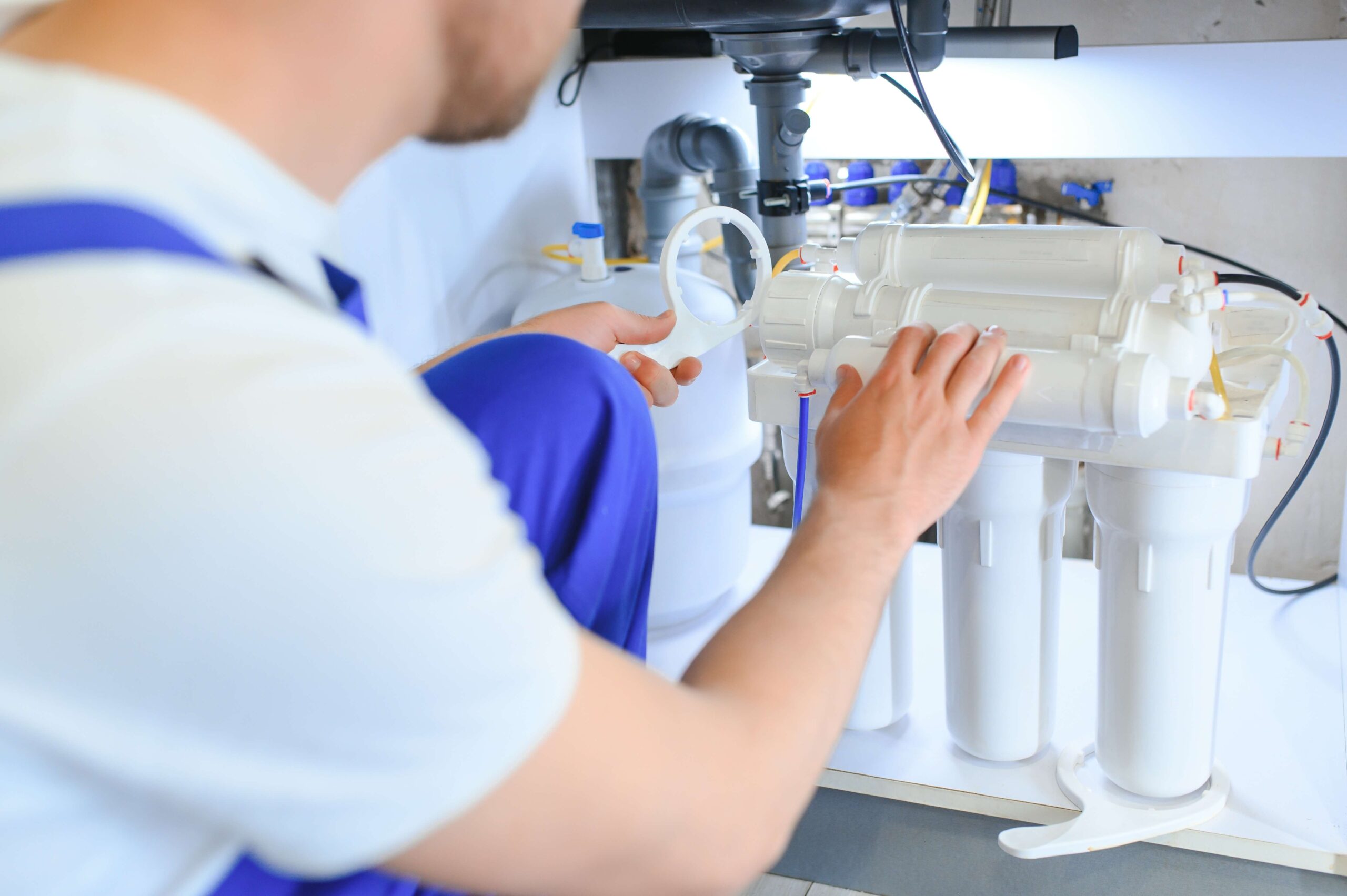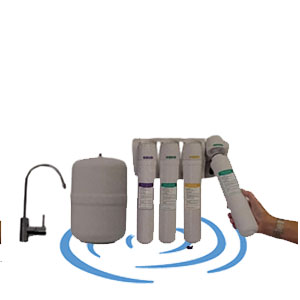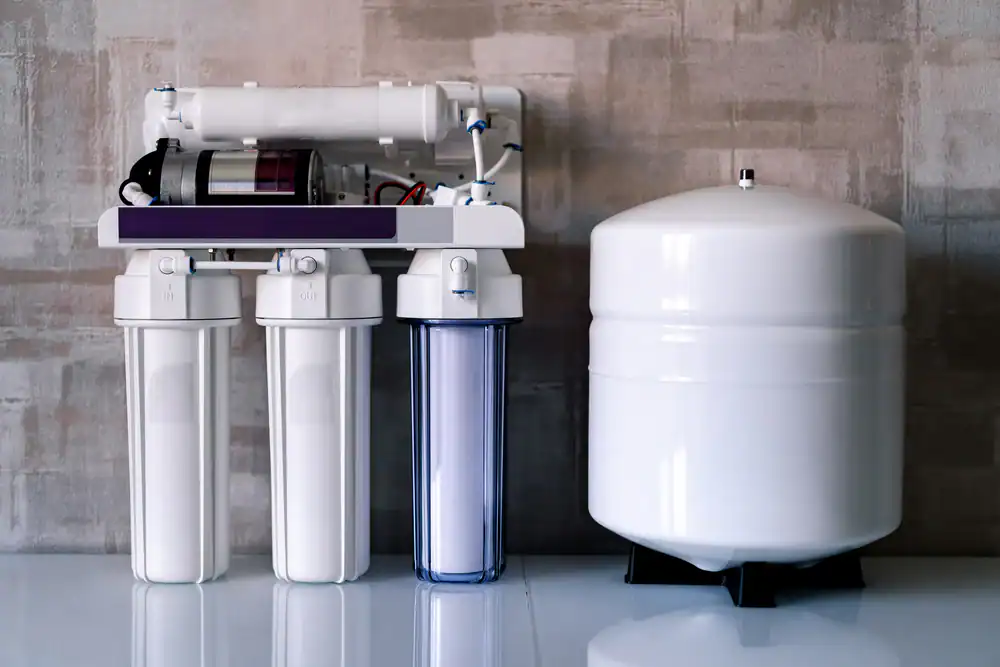Summary:
How Reverse Osmosis Systems Work for Lake County Water
Reverse osmosis is a pressure-driven water treatment process that uses a membrane to separate dissolved minerals and contaminants from water. Think of it as nature’s most effective filter, working at the molecular level to remove what other systems can’t touch.
The process is straightforward but powerful. Pressure forces water through a semi-permeable membrane, creating a stream of treated water called “permeate” and a stream of reject water called “concentrate” or “brine”. The holes in an RO membrane are just large enough for a water molecule, meaning even small particles won’t pass through, giving you contaminant-free, great-tasting water.
What makes this especially relevant for Lake County is how well RO systems handle our specific water challenges. Florida’s groundwater permeates through limestone, picking up magnesium and calcium that makes water hard, while municipal treatment adds chlorine for safety that affects taste.
What Contaminants Does RO Remove from Florida Water
RO systems deliver stunning water quality by reducing several common water contaminants by 98% or more. For Lake County homeowners, this means addressing the specific issues that make our water challenging to drink and use.
These systems can potentially remove water contaminants such as lead, volatile organic compounds (VOCs), PFAS, arsenic, bacteria, and viruses. But what does that mean for your daily experience? RO provides added health benefits by ensuring lead, chlorine, fluoride, and other impurities are removed. If you have a water softener and are concerned about extra sodium, an RO system can remove that as well.
The taste difference is immediate and noticeable. Water in its purest form has no odor or flavor – when you “taste” water, you’re actually tasting what’s dissolved in it, and most people who dislike their home’s water taste will prefer reverse osmosis filtered water. While chlorine effectively kills harmful bacteria, it leaves behind a strong chemical taste that’s especially noticeable when combined with natural sulfur content.
Recent research backs up these benefits. A 2024 study showed that RO systems remove over 95% of harmful PFAS chemicals, while a Duke University review found these systems consistently removed 90-99% of contaminants even in homes with variable water chemistry. For families concerned about long-term health impacts, this level of protection provides real peace of mind.
Why Lake County Homeowners Choose Professional Installation
Installing an RO system isn’t just about buying equipment – it’s about getting a solution that actually works for your specific water conditions and home setup. A reverse osmosis filtration system needs to be connected to your water line, and expert installation should come with a full walkthrough of the system and how it works, plus answers to any questions about usage and maintenance.
Lake County’s water presents unique challenges that require local expertise. Disinfectants and disinfection byproducts like chlorine, haloacetic acids, and total trihalomethanes make for unpleasant tasting water across the state. Central Florida has high levels of sulfur in groundwater from underground aquifers rich in sulfur, giving water a “rotten egg” smell and taste. We understand these local conditions and can recommend the right system configuration.
The installation process matters for long-term performance. A plumber can set up a point-of-use unit in one to two hours, while a whole-house system takes one to two days because it ties into the main supply line and may require extra plumbing. During installation, we mount the unit, connect pipes, check for leaks, and test performance.
Professional installation also protects your investment. Systems can last for over ten years if properly maintained, but improper installation can lead to leaks, reduced efficiency, or premature component failure. When you’re investing in your family’s water quality, professional installation ensures you get the full benefit of your system from day one.
RO System Installation Cost and Value in Lake County, FL
Understanding RO system costs helps you make an informed decision that fits your budget and water quality needs. The average cost to install a reverse osmosis water filtration system ranges from $1,000 to $4,000, with most homeowners spending around $2,500, including both the system and professional installation. The type and size of system, capacity, and number of filtration stages significantly impact the project’s cost.
The investment makes sense when you consider what you’re getting. Reverse osmosis filtration can produce clean, filtered water for pennies per gallon. Investing in an RO system means you won’t buy bottled water, haul water jugs from the grocery store, or pay for a water delivery service. For families spending $50-100 monthly on bottled water, the system often pays for itself within 2-3 years.
Under-Sink vs Whole House RO Systems: Which is Right for You
The choice between under-sink and whole-house systems depends on your specific needs and budget. Under-sink systems typically cost between $150 and $600 with an average of about $300, plus an additional $100 to $500 for professional installation. These systems are installed under the kitchen sink, provide high-quality drinking water, and are ideal for those looking for a balance between cost and efficiency. Cost varies based on filtration stages, capacity, and features like booster pumps.
For many families, an under-sink RO system provides great-tasting drinking water at the point of use while the entire home benefits from a whole-house filtration system. This approach makes sense because the majority of water used in homes is not consumed for drinking, but used for flushing toilets and bathing, so it’s typically not necessary to have high-quality “RO filtered water” for your entire home.
Whole-house systems cost more but treat all water entering your home. The average cost for a whole-house reverse osmosis system ranges from $1,000 to $4,000, with most homeowners paying around $2,500. However, large RO systems use a lot of water – roughly two gallons are needed to create one gallon of filtered water, so you can expect your water bill to double.
The decision often comes down to your water quality issues and usage patterns. If your main concern is drinking water quality, an under-sink system provides excellent results at a lower cost. If you have severe water quality issues affecting bathing, laundry, and appliances throughout the house, a whole-house system might be worth the investment.
Long-Term Costs and Maintenance for Lake County RO Systems
Understanding ongoing costs helps you budget for the full ownership experience. RO membranes or filters require regular replacement, costing around $100 annually depending on the manufacturer. Whole house and complex systems should be professionally inspected annually, which may add $100 to $200 to household maintenance costs.
To keep your reverse osmosis system running smoothly, it’s essential to change filters regularly. Many homeowners aim for once a year, but swapping them out every six months helps maintain the best water quality. Basic filter sets range from $40 to $90, but larger systems or specialized filters could cost $100 to $300 per year.
The good news is that most RO systems don’t require much day-to-day attention but need occasional care to stay in peak condition. Plan to sanitize the system and inspect for leaks about once a year. Many homeowners can handle this maintenance themselves by following the system’s manual, saving on service costs.
Lake County’s water conditions can affect maintenance frequency. Hard water and high mineral content may require more frequent filter changes, but a properly sized and professionally installed system will handle local water conditions efficiently. The minerals and iron in hard water can clog and damage the reverse osmosis membrane, reducing system lifespan, which is why water softeners are often recommended before RO systems.
Quality matters when it comes to longevity. Some RO filters last up to two years, while the reverse osmosis membrane lasts up to five years. Other systems may not offer this kind of longevity, especially in the RO membrane, which means you’ll end up paying more over time. Investing in a quality system with professional installation and regular maintenance ensures you get the full benefit of clean, great-tasting water for years to come.
Getting Started with RO System Installation in Lake County
Installing a reverse osmosis system isn’t just convenient – it’s one of the most effective ways to protect your family’s water quality. For Lake County homeowners dealing with chlorine taste, hard water minerals, or sulfur odors, an RO system provides a comprehensive solution that addresses multiple water quality issues at once.
The key to success is working with experienced professionals who understand local water conditions and can recommend the right system for your specific needs and budget. Whether you choose an under-sink system for drinking water or a whole-house solution, proper installation and regular maintenance ensure you get clean, great-tasting water that your family will love.
Ready to transform your water quality? Contact Quality Safe Water of Florida to schedule your free water analysis and learn how a professionally installed reverse osmosis system can solve your water quality challenges and provide peace of mind for years to come.




